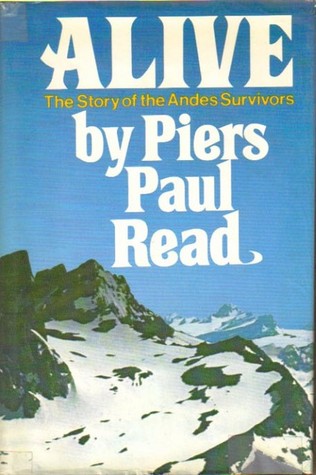
On October 12, 1972, a plane carrying a team of young rugby players crashed into the remote, snow-peaked Andes. Out of the 45 original passengers and crew, only 16 made it off the mountain alive. For 10 excruciating weeks, they suffered deprivations beyond imagining, confronting nature head-on at its most furious and inhospitable. And to survive, these men and women not only had to keep their faith; they had to make an impossible decision: Should they eat the flesh of their dead friends?
A remarkable story of endurance and determination, Alive is the dramatic best-selling account of one of the most harrowing quests for survival in modern times.
Non-Fiction Book Review Blog: Alive
I can say, without the slightest hesitation, that I can attribute my fear of flying to the 1993 film, Alive. At the time, I was thirteen years old and have been on a fair share of trips that included being on an airplane, namely to the Dominican Republic or to Florida. I marveled at the beautiful scenery as I soared, encased in an aluminum can thirty-five thousand feet in the air. But I was safe. Nothing bad can come from this… right? Enter Alive.
There is no doubt that it was a film that my dad picked up on his weekly video store runs for our Friday movie nights. As far as I can remember, most of the films he brought home were cheap horror B-movies. So when I saw the title, Alive, adorned on the VHS label, I chocked it off as another poor, yet fun, horror film. The film opens with a monologue from actor John Malkovich. I could immediately tell that this was a higher-caliber production. After a brief introduction, we are introduced to a plane soaring just above the mountainous region of the Andes. This was followed by what has to be one of the most disturbing depictions of a plane crash from presumable, first-hand accounts from the survivors. It was all fun and games aboard when WHAM! Just like that, we are in a dire situation, and the only thing the folks on board is a prayer and a little bit of luck.
Author Piers Paul Read was not aboard the doomed flight. Still, he gathered information from the surviving members and accounts from family members and officials who were part of the search crew. He writes their ordeals in a matter-of-fact manner, with no embellishments, “pizzaz,” or exaggeration. He is merely relaying stories as they were told to him, raw and uncut with no filters. There was a sense that what happened needed to happen for their survival, and no apologies were made.
For those familiar with this incident, it is no secret that one of the things deemed necessary for their survival was that they had to resort to cannibalism of their fallen comrades. This fact was presented as a necessity and not one that the survivors wanted to do. These scenes were gut and heart-wrenching to have to read about the young men having to resort to this atrocity and eating members of their teammates, friends, and even family. It was a harrowing feat that anyone would be hard-pressed to pass judgment given the circumstances.
As was the film adaptation, Read’s Alive only further instilled a greater sense of anxiety when even the thought of flying crossed my mind. As mentioned previously, Read does give what seems to be a reasonably accurate account of the happenings that led to the crash, the experiences told to him by the survivors, as well as their eventual rescue. However, because he was not a passenger on board, there was a slight sense of disconnect as I had a hard time being emotionally connected to anyone in particular. I found myself growing connected to someone only to read of their eventual passing. As described by the author, it was inevitable; it was almost as if I was supposed to expect instead of giving more light and hope. There seemed to always be a foreboding sense of doom and dread. But then again, the feelings that spewed out of the pages were most likely the same sentiments that the crash survivors and their family members felt at the time. Alive is a fantastic read that grips your terror and tugs at the very core of your nerves.
